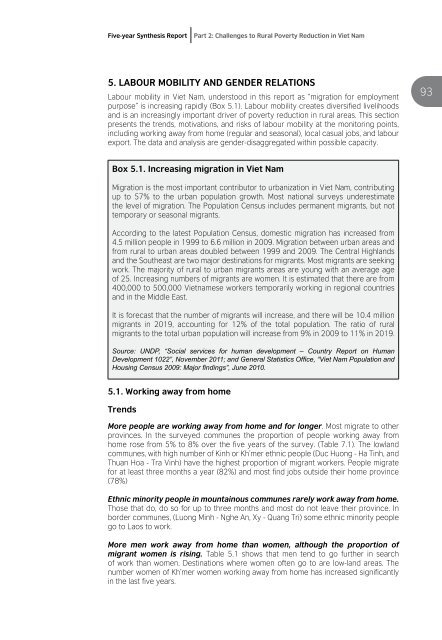Challenges to Rural Poverty Reduction in Viet Nam - Oxfam Blogs
Challenges to Rural Poverty Reduction in Viet Nam - Oxfam Blogs
Challenges to Rural Poverty Reduction in Viet Nam - Oxfam Blogs
Create successful ePaper yourself
Turn your PDF publications into a flip-book with our unique Google optimized e-Paper software.
Five-year Synthesis Report<br />
Part 2: <strong>Challenges</strong> <strong>to</strong> <strong>Rural</strong> <strong>Poverty</strong> <strong>Reduction</strong> <strong>in</strong> <strong>Viet</strong> <strong>Nam</strong><br />
5. LABOUR MOBILITY AND GENDER RELATIONS<br />
Labour mobility <strong>in</strong> <strong>Viet</strong> <strong>Nam</strong>, unders<strong>to</strong>od <strong>in</strong> this report as “migration for employment<br />
purpose” is <strong>in</strong>creas<strong>in</strong>g rapidly (Box 5.1). Labour mobility creates diversified livelihoods<br />
and is an <strong>in</strong>creas<strong>in</strong>gly important driver of poverty reduction <strong>in</strong> rural areas. This section<br />
presents the trends, motivations, and risks of labour mobility at the moni<strong>to</strong>r<strong>in</strong>g po<strong>in</strong>ts,<br />
<strong>in</strong>clud<strong>in</strong>g work<strong>in</strong>g away from home (regular and seasonal), local casual jobs, and labour<br />
export. The data and analysis are gender-disaggregated with<strong>in</strong> possible capacity.<br />
93<br />
Box 5.1. Increas<strong>in</strong>g migration <strong>in</strong> <strong>Viet</strong> <strong>Nam</strong><br />
Migration is the most important contribu<strong>to</strong>r <strong>to</strong> urbanization <strong>in</strong> <strong>Viet</strong> <strong>Nam</strong>, contribut<strong>in</strong>g<br />
up <strong>to</strong> 57% <strong>to</strong> the urban population growth. Most national surveys underestimate<br />
the level of migration. The Population Census <strong>in</strong>cludes permanent migrants, but not<br />
temporary or seasonal migrants.<br />
Accord<strong>in</strong>g <strong>to</strong> the latest Population Census, domestic migration has <strong>in</strong>creased from<br />
4.5 million people <strong>in</strong> 1999 <strong>to</strong> 6.6 million <strong>in</strong> 2009. Migration between urban areas and<br />
from rural <strong>to</strong> urban areas doubled between 1999 and 2009. The Central Highlands<br />
and the Southeast are two major dest<strong>in</strong>ations for migrants. Most migrants are seek<strong>in</strong>g<br />
work. The majority of rural <strong>to</strong> urban migrants areas are young with an average age<br />
of 25. Increas<strong>in</strong>g numbers of migrants are women. It is estimated that there are from<br />
400,000 <strong>to</strong> 500,000 <strong>Viet</strong>namese workers temporarily work<strong>in</strong>g <strong>in</strong> regional countries<br />
and <strong>in</strong> the Middle East.<br />
It is forecast that the number of migrants will <strong>in</strong>crease, and there will be 10.4 million<br />
migrants <strong>in</strong> 2019, account<strong>in</strong>g for 12% of the <strong>to</strong>tal population. The ratio of rural<br />
migrants <strong>to</strong> the <strong>to</strong>tal urban population will <strong>in</strong>crease from 9% <strong>in</strong> 2009 <strong>to</strong> 11% <strong>in</strong> 2019.<br />
Source: UNDP, “Social services for human development – Country Report on Human<br />
Development 1022”, November 2011; and General Statistics Office, “<strong>Viet</strong> <strong>Nam</strong> Population and<br />
Hous<strong>in</strong>g Census 2009: Major f<strong>in</strong>d<strong>in</strong>gs”, June 2010.<br />
5.1. Work<strong>in</strong>g away from home<br />
Trends<br />
More people are work<strong>in</strong>g away from home and for longer. Most migrate <strong>to</strong> other<br />
prov<strong>in</strong>ces. In the surveyed communes the proportion of people work<strong>in</strong>g away from<br />
home rose from 5% <strong>to</strong> 8% over the five years of the survey. (Table 7.1). The lowland<br />
communes, with high number of K<strong>in</strong>h or Kh’mer ethnic people (Duc Huong - Ha T<strong>in</strong>h, and<br />
Thuan Hoa - Tra V<strong>in</strong>h) have the highest proportion of migrant workers. People migrate<br />
for at least three months a year (82%) and most f<strong>in</strong>d jobs outside their home prov<strong>in</strong>ce<br />
(78%)<br />
Ethnic m<strong>in</strong>ority people <strong>in</strong> mounta<strong>in</strong>ous communes rarely work away from home.<br />
Those that do, do so for up <strong>to</strong> three months and most do not leave their prov<strong>in</strong>ce. In<br />
border communes, (Luong M<strong>in</strong>h - Nghe An, Xy - Quang Tri) some ethnic m<strong>in</strong>ority people<br />
go <strong>to</strong> Laos <strong>to</strong> work.<br />
More men work away from home than women, although the proportion of<br />
migrant women is ris<strong>in</strong>g. Table 5.1 shows that men tend <strong>to</strong> go further <strong>in</strong> search<br />
of work than women. Dest<strong>in</strong>ations where women often go <strong>to</strong> are low-land areas. The<br />
number women of Kh’mer women work<strong>in</strong>g away from home has <strong>in</strong>creased significantly<br />
<strong>in</strong> the last five years.

















